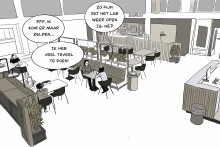‘This is a scale model of a measuring tower of the Einstein Telescope,’ Marcel ter Brake says. ‘We are still finishing it up for our research.’ He points to an impressive-looking matte-steel capsule about three meters in diameter and roughly the same height. The towers of the Einstein Telescope will be much larger however: around 20 meters in size.
The device reminds of a space module, with its curved shapes and circular openings resembling windows. Inside, shiny steel with rounded holes gives an even more spacy feeling. But this piece of ingenuity will never see outer space. Instead, it will be used to design custom-made technology for the Einstein Telescope. Ter Brake and his team will contribute to this mega project by developing vibration-free cooling designed to fit inside the tower. ‘Even the smallest vibrations may interfere with the measurements,’ ter Brake explains. ‘For over 20 years, we have gathered quite some experience in such cooling systems, among others in European Space Agency projects.’
 Extreme event
Extreme event
The main aim of the Einstein Telescope is to measure gravitational waves. These are caused by events in the Universe where massive objects move with extreme increases in speed, for example, when two black holes merge. Such an extreme event causes a gravitational wave that spreads over space like a rock that is thrown into a pond. These ripples travel through the Universe with the speed of light and eventually reach the Earth. They contain information about their creation as well as gravity itself. However, when these waves reach the earth’s surface, often billions of years later, they have dramatically reduced in power and are almost undetectable. Six years ago, in 2015, the LIGO observatory in the USA, announced a breakthrough: for the first time, gravitational waves were detected. The unimaginably tiny signal measured was not more than a soft whisper from space: it was only 0.1 percent the size of the nucleus of an atom, resulting from a collision of two black holes billions of years ago.
Special design
The Einstein Telescope is not a telescope in the usual sense. It will measure gravitational waves using so-called laser interferometry, the same technology as used in LIGO. ‘A laser beam is emitted through a long vacuum tube, and is reflected by suspended mirrors at the ends of the tube,’ ter Brake explains. ‘A gravitational wave coming from space slightly changes the distance between the mirrors and this can be detected as a tiny optical signal.’ To measure such incredibly small signals requires a special design. The Einstein telescope has huge dimensions, resembling a triangle with 10 kilometers long sides and buried 250 to 300 meters underground to minimize vibrations. In addition, by letting the laser bounce several times between the mirrors, before they reach the detector, the signal can be increased. But this is not enough to achieve the 10 to 100 times higher sensitivity compared to previous systems, that the Einstein telescope aims for. Even molecular vibrations from the mirror surface may interfere with the signal. ‘Therefore, we have to eliminate even these tiny vibrations,’ ter Brake says. ‘The most effective way is to cool the system down close to absolute zero, -273 °C, where even molecules don’t move anymore. This is where our expertise comes in.’

Extreme cooling
For about 20 years, the UT has developed state of the art cooling technologies that were able to cool to temperatures far below zero degrees Celsius. For such extreme cooling the scientists use a similar principle as in an ordinary fridge, but to avoid vibrations, they don’t use a mechanical compressor, the motor of the fridge. Instead, they have modified and perfected a thermal, vibration-free, compressor technology invented by Philips in the 1960’s. To reach the incredibly low temperatures of several hundred degrees below zero, ter Brake and his team developed a three-stage cooling system, using different cooling gasses.
'Our completely vibration-free cooling system literally freezes all tiny molecular movements'
Ter Brake: ‘Using this method, we have managed to stepwise reach temperatures as low as -265 °C, that is almost absolute zero. Our completely vibration-free cooling system literally freezes all tiny molecular movements that could potentially interfere with the measurements.’

Complete scale model
Now the technology has been developed, the main challenge is to custom-design it for the Einstein Telescope. Here, the scale model of the vacuum tower inside the hall of UT’s High-Pressure Lab, will play a key role. The team will gather experience with the most efficient way of cooling the mirrors and their suspension system and how to fit in in the tower. They also need to critically examine if their system truly is vibration free. Ter Brake: ‘We need for example check for possible vibrations in the gas tubes.’
When the experiments in Twente are successfully completed, which should be in the second half of 2023, the technology will be applied in a complete scale model called the Einstein Telescope Pathfinder in Maastricht. When everything works out, the gigantic Telescope will be built in either Sardinia, Italy, or in the Rhine-Meuse region near Maastricht.
'The development of such complicated technology to measure these ‘voices from space’ may lead to important breakthroughs in other areas as well'
Although costs of the whole project are astronomical, about two billion euro, the benefits are huge as well. ‘Gravitational waves provide a wealth of information regarding the Universe, the creation of space, including the Big Bang,’ ter Brake explains. ‘At the same time, the development of such complicated technology to measure these ‘voices from space’ may lead to important breakthroughs in other areas as well. For example, vibration-free cooling is crucial in quantum computers, but also in protein and virus studies where cryo-electron microscopy is used, this technology can be extremely useful.’




 Extreme event
Extreme event




